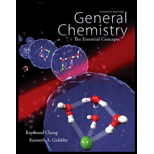
Interpretation:
The initial rate of the given reaction at the given temperature has to be calculated.
Concept introduction:
Rate equation for the general reaction
Rate constants are independent of concentration but depend on other factors, most notably temperature.
The reaction with the faster rate will have the larger rate constant.
Order of a reaction: The sum of exponents of the concentrations in the rate law for the reaction is said to be order of a reaction.
The partial pressure of a gas in a mixture can be expressed as,
The
Answer to Problem 14.115SP
Initial rate of the given reaction is
Explanation of Solution
Given,
Gas mixture containing
The elementary reaction is,
This reaction follows second order kinetics, with a rate constant of
Given mole fractions of
The initial rate of the reaction at
Rate law for the given reaction is,
Rate constant value for the given reaction is
Using mole fraction value and total partial pressure, partial pressure of each reactant in the reaction can be calculated as follows,
Molar concentration of reactants can be determined with the help of ideal gas equation,
Substitute the concentration and the rate constant into the rate law to find the initial rate of the reaction,
Want to see more full solutions like this?
Chapter 14 Solutions
Package: General Chemistry with Connect 2-year Access Card
 ChemistryChemistryISBN:9781305957404Author:Steven S. Zumdahl, Susan A. Zumdahl, Donald J. DeCostePublisher:Cengage Learning
ChemistryChemistryISBN:9781305957404Author:Steven S. Zumdahl, Susan A. Zumdahl, Donald J. DeCostePublisher:Cengage Learning ChemistryChemistryISBN:9781259911156Author:Raymond Chang Dr., Jason Overby ProfessorPublisher:McGraw-Hill Education
ChemistryChemistryISBN:9781259911156Author:Raymond Chang Dr., Jason Overby ProfessorPublisher:McGraw-Hill Education Principles of Instrumental AnalysisChemistryISBN:9781305577213Author:Douglas A. Skoog, F. James Holler, Stanley R. CrouchPublisher:Cengage Learning
Principles of Instrumental AnalysisChemistryISBN:9781305577213Author:Douglas A. Skoog, F. James Holler, Stanley R. CrouchPublisher:Cengage Learning Organic ChemistryChemistryISBN:9780078021558Author:Janice Gorzynski Smith Dr.Publisher:McGraw-Hill Education
Organic ChemistryChemistryISBN:9780078021558Author:Janice Gorzynski Smith Dr.Publisher:McGraw-Hill Education Chemistry: Principles and ReactionsChemistryISBN:9781305079373Author:William L. Masterton, Cecile N. HurleyPublisher:Cengage Learning
Chemistry: Principles and ReactionsChemistryISBN:9781305079373Author:William L. Masterton, Cecile N. HurleyPublisher:Cengage Learning Elementary Principles of Chemical Processes, Bind...ChemistryISBN:9781118431221Author:Richard M. Felder, Ronald W. Rousseau, Lisa G. BullardPublisher:WILEY
Elementary Principles of Chemical Processes, Bind...ChemistryISBN:9781118431221Author:Richard M. Felder, Ronald W. Rousseau, Lisa G. BullardPublisher:WILEY





